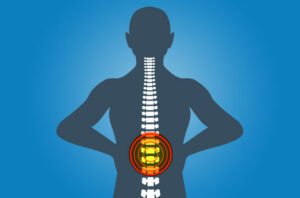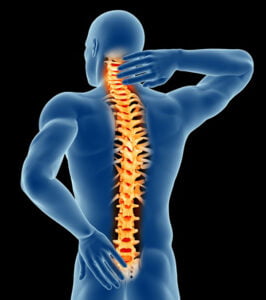Mid-back pain, also known as thoracic pain, can be an uncomfortable and debilitating condition that affects a significant portion of the population. While back pain in general can arise due to various reasons, this article will specifically focus on right-sided mid-back pain. Understanding the causes, symptoms, and treatment options for Middle Right Back Pain is essential for effectively managing and alleviating the discomfort.
Contents
Understanding Mid Back Pain

Mid-back pain refers to discomfort or pain that occurs in the area between the base of the neck (cervical spine) and the lower back (lumbar spine). This region is known as the thoracic spine and consists of 12 vertebrae labeled T1 to T12.
The thoracic spine is less mobile compared to the cervical and lumbar regions because it is attached to the rib cage, providing stability and protection for vital organs in the chest. However, despite its relative stability, the thoracic spine can still experience pain and discomfort due to various factors.
Diagnosing Mid Back Pain
Diagnosing the underlying cause of mid-back pain typically involves a comprehensive evaluation by a healthcare professional. Here’s an outline of the steps typically involved in diagnosing mid-back pain:
- Medical History: The doctor will begin by taking a detailed medical history, including questions about the onset of the pain, its location, duration, and any factors that worsen or alleviate it. They will also inquire about any previous injuries, medical conditions, or family history of spinal issues.
- Physical Examination: A physical examination will be conducted to assess the spine’s range of motion, posture, and any signs of muscle tension, inflammation, or neurological issues. The doctor may press on certain areas to identify tender points or trigger points.
- Imaging Studies: To visualize the structures of the mid back, the doctor may order imaging studies such as X-rays, MRI (Magnetic Resonance Imaging), or CT (Computed Tomography) scans. These imaging techniques can help detect issues with the bones, discs, and soft tissues.
- Electromyography (EMG): In cases where nerve-related problems are suspected, an EMG may be conducted to assess nerve function and identify any abnormalities.
Specific Causes of Right-Sided Mid Back Pain

Right-sided mid-back pain can have several specific causes, ranging from muscular issues to problems with the spine or organs in the area. Here are some common specific causes of right-sided mid-back pain:
- Muscle Strain: Overuse or injury to the muscles on the right side of the mid back can cause localized pain. This could result from improper lifting, repetitive motions, or sudden movements.
- Rib Dysfunction: Dysfunction or misalignment of the ribs on the right side can lead to mid-back pain. This may be caused by trauma, muscle imbalances, or postural issues.
- Thoracic Herniated Disc: A herniated disc in the thoracic spine on the right side can compress nearby nerves, leading to mid-back pain. However, thoracic disc herniations are less common than lumbar or cervical disc herniations.
- Osteoarthritis: Degeneration of the facet joints in the thoracic spine on the right side can cause pain and stiffness.
- Scoliosis: Right-sided curvature of the spine (right thoracic scoliosis) can lead to mid-back pain as the body tries to compensate for the abnormal alignment.
- Kidney Stones: Right-sided mid-back pain can occur if a kidney stone is located in the right kidney or right ureter. Pain may radiate from the flank area to the mid back.
- Gallbladder Issues: Inflammation or gallstones in the gallbladder can cause referred pain to the right mid-back.
- Peptic Ulcer: A peptic ulcer in the stomach or duodenum can cause right-sided mid-back pain in some cases.
Treatment Options
The treatment options for right-sided mid-back pain depend on the underlying cause of the pain. Here are some general treatment approaches that may be used to address mid-back pain:
- Rest and Activity Modification: If the pain is due to muscle strain or overuse, resting the affected area and avoiding activities that worsen the pain can help promote healing.
- Pain Medications: Over-the-counter pain relievers, such as acetaminophen or nonsteroidal anti-inflammatory drugs (NSAIDs), may help reduce pain and inflammation.
- Heat and Ice Therapy: Applying heat packs or ice packs to the painful area can provide relief and reduce muscle spasms or inflammation.
- Physical Therapy: A physical therapist can design exercises and stretches to improve flexibility, strengthen the muscles supporting the mid back, and correct postural issues.
- Posture Correction: Learning and maintaining good posture can help alleviate mid-back pain caused by poor alignment.
- Massage and Myofascial Release: Massage therapy can help relax tense muscles and release trigger points in the mid-back region.
Alternative and Complementary Therapies
. Here are some alternative and complementary therapies that may be considered:
- Acupuncture: Acupuncture is an ancient Chinese therapy that involves the insertion of thin needles into specific points on the body to promote the flow of energy (qi). Some people find relief from mid-back pain through acupuncture sessions.
- Yoga: Yoga combines physical postures, breathing exercises, and meditation. Certain yoga poses can help stretch and strengthen the muscles of the mid back, improve flexibility, and promote relaxation.
- Pilates: Pilates focuses on core strength, flexibility, and proper alignment. It can be beneficial for improving posture and strengthening the muscles supporting the mid back.
- Chiropractic Care: Chiropractors use spinal adjustments and manipulations to address misalignments in the spine, which may help alleviate mid-back pain caused by musculoskeletal issues.
- Herbal Remedies: Some herbal supplements, such as turmeric, devil’s claw, or white willow bark, are believed to have anti-inflammatory properties and may provide relief from mid-back pain.
Lifestyle Modifications for Managing Mid Back Pain

Lifestyle modifications play a crucial role in managing mid-back pain and promoting spine health. Incorporating healthy habits into your daily routine can help reduce the risk of pain flare-ups and improve overall well-being. Here are some lifestyle modifications to consider:
- Maintain Good Posture: Practice proper posture while sitting, standing, and walking. Avoid slouching and keep your shoulders back and relaxed. Consider using ergonomic chairs and supportive cushions if you spend long hours sitting at a desk.
- Regular Exercise: Engage in low-impact exercises that strengthen the core and back muscles, such as walking, swimming, or yoga. Strengthening the muscles supporting the mid back can improve stability and reduce the risk of pain.
- Stretching: Incorporate regular stretching exercises to improve flexibility and reduce muscle tension. Focus on stretching the muscles of the mid back, chest, and shoulders.
- Weight Management: Maintain a healthy weight to reduce the strain on the spine. Excess weight can put additional pressure on the mid back and exacerbate pain.
- Avoid Prolonged Inactivity: Avoid sitting or standing in the same position for extended periods. Take breaks to move around and stretch at regular intervals if you have a sedentary job.
- Lift Properly: When lifting heavy objects, use your legs instead of your back to lift the weight. Bend at the knees and keep the object close to your body while lifting.
- Sleep Position: Choose a mattress and pillow that provide adequate support for your spine and try sleeping on your side with a pillow between your knees to maintain spinal alignment.
Tips for Long-Term Back Health
Regular check-ups with healthcare providers and incorporating core-strengthening exercises into daily routines can help maintain long-term back health. Avoiding a sedentary lifestyle is also essential for reducing the risk of mid-back pain.
Exercises for Right-Sided Mid Back Pain
Stretching and strengthening exercises can aid in alleviating right-sided mid-back pain. However, it is essential to perform these exercises correctly and consider any precautions to avoid exacerbating the condition.
Managing Mid Back Pain at Work
For office workers or individuals with desk jobs, implementing ergonomic tips and taking regular breaks to move and stretch can minimize the impact of prolonged sitting on mid-back pain.
Maintaining Emotional Well-being
Emotional health plays a significant role in pain management. Finding healthy coping mechanisms and addressing emotional well-being can positively influence the perception of pain.
Importance of Consulting Healthcare Professionals
It is crucial to consult healthcare professionals for an accurate diagnosis and personalized treatment plan. A holistic approach that considers individual needs can lead to more effective and sustainable pain management.
Conclusion
In conclusion, right-sided mid-back pain can significantly impact one’s daily life and overall well-being. Understanding the various causes, treatment options, and preventive measures can empower individuals to manage and alleviate this discomfort effectively. By adopting a comprehensive approach that includes both conventional and alternative therapies, as well as lifestyle modifications, individuals can work towards maintaining a healthy back and enjoying an improved quality of life.
If you’re experiencing Back pain, physical therapy for back pain at PhysioMantra can help: Book an online physical therapy session.



